- Learning time
- 20 minutes
- First play time
- 60 minutes
Neue Heimat / The Estates
Designed by: Klaus Zoch
Neue Heimat (German for New Homeland, republished as The Estates in 2018) is an abstract game with lots of scope for devilment. The players are developers looking to build homes, but beyond the fact that some building takes place, the theme is wafer-thin. The gameplay however, can be extremely feisty!
The small board shows a road on one side, and then three rows of building plots. To one side are the coloured building pieces (with a numeric value between 1 and 6) the roof pieces (a building isn’t complete until it has a roof!), the mayor piece, and some building permits that can either reduce or advance the number of plots available.
Each player begins with 12 money, and the active player chooses any one of the building peices to auction. The active player doesn’t bid: they can either take the money from the highest bidder and pass the piece to them, or pay the highest bidder, and take the piece themselves. Whoever ends up with it places the piece on the board. If the winning bidder is the first player to take a piece of that particular colour, they take an ownership marker to show they own that colour. Pieces can either go in a new plot, or on top of a previously-built piece – as long as the number is lower than the number it’s going on top of.
Ownership markers are important, because the colour of the top level of a building denotes ownership, and only buildings you own will score you points at the end of the game.
But building isn’t the half of it. You have other things to consider – firstly, the fact that opponents will react to your strong position on a particular row by ensuring (or attempting to) that the row doesn’t get finished, which means it will score negative points at the end of the game. They can do this by making sure the building pieces or roofs go elsewhere, or by extending that row (using the permits) to the point where trying to complete it is a fool’s errand. It’s quite possible that all players finish below zero. Third, the mayor, when won in a bid, can either be chucked out of the game or assigned to a particular row. Once he’s there, that row will score double, whether it’s completed or not. So the mayor might be a great thing if placed next to your completed row, but next to an unfinished one, he doubles your negative points!
Finally all players have the option to ‘stash’ 1 money at the start of their turn, which represents one point at the end of the game. In a game of limited economy, this can be risky. But in a game where points can swing wildly, it can also be extremely shrewd. Play continues until either two of the plot rows are completed (with a roof on every building) or the building and roof pieces run out.
Joe says
I've played once. A unique experience, and probably a game best played amongst friends with a) thick skins and b) a good grasp of the flow of play. Dastardly.
The guru's verdict
-
Take That!
Take That!
High. The game is essentially a 45 minute act of multi-player sabotage and brutality.
-
Fidget Factor!
Fidget Factor!
Low. Everyone is involved in the bidding, and if you're out of money you can at least indulge in wails of despair whilst everyone sticks the knife in to your building schemes.
-
Brain Burn!
Brain Burn!
There's certainly the potential for brain-burning, on a first play in particular. You're juggling which piece to offer with which players will build and how much they'll bid and where they'll place it and how this will affect you and how much you're willing to bid or forego in order to stay competitive... BUT, the depth of the game is in the act of decision-making. The rules are actually pretty simple.
-
Again Again!
Again Again!
There's an enormous amount of variety in playing Neue Heimat - the building pieces are always arranged randomly and the smallest change in strategy by one player has knock-on effects for the rest of the game.

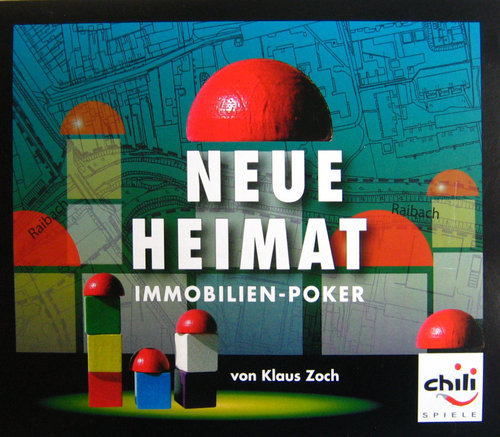
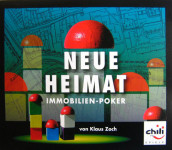
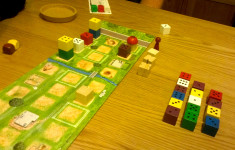
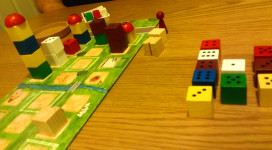



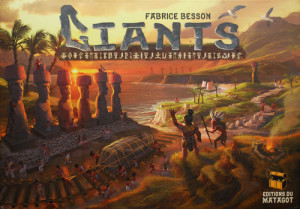

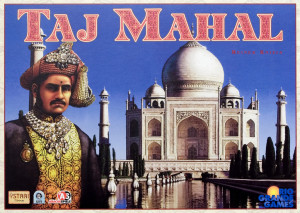
Sam says
When we first played this I joked that someone could 'stash' a card on every turn and score a miserable 10 or so points. Then somebody did exactly that, and won convincingly whilst I finished on -79. That taught me that this game is really not about building, it's about messing with each other's business, as much as you possibly can. Because while 'stashing' might sound a boring strategy, to pull it off you still need to ensure you have money in your hand, and make sure the players who are building are going to get hit with minus points. It's an utterly brutal game, and if you relish the chance to screw each other over, this has it in spades.